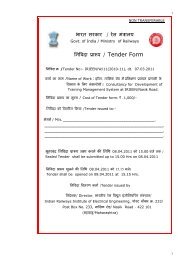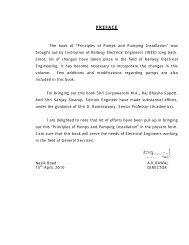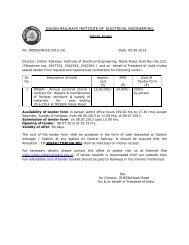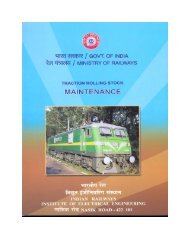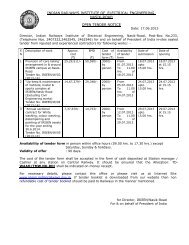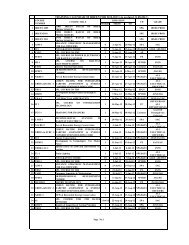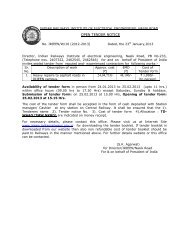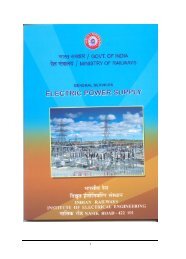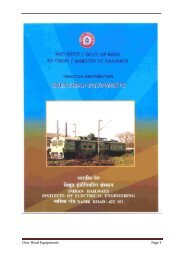remote control equipment - Indian Railways Institute of Electrical ...
remote control equipment - Indian Railways Institute of Electrical ...
remote control equipment - Indian Railways Institute of Electrical ...
You also want an ePaper? Increase the reach of your titles
YUMPU automatically turns print PDFs into web optimized ePapers that Google loves.
f) When grid supply to any traction sub-station fails and consequent<br />
emergency working has to be resorted to by extending the feed from<br />
adjacent sub-stations, the maximum demand at these sub-stations may<br />
go up. Most Supply Authorities have agreed to ignore such temporary<br />
increase in maximum demand for billing purpose. Where this has not<br />
yet agreed to, efforts should be continued to persuade the Supply<br />
Authorities to accept this principle.<br />
g) The present methodology <strong>of</strong> measuring maximum demand at each<br />
individual sub-stations for the purpose <strong>of</strong> billing has been reviewed by<br />
the Central Electricity Authority. It has been that <strong>Railways</strong> should be<br />
charged for traction power on the basis <strong>of</strong> simultaneous maximum<br />
demand recorded in contiguous sub-stations <strong>of</strong> the SEB serviced by<br />
the same grid transformers. Modalities to implement the decision would<br />
have to be mutually settled between SEB’s and <strong>Railways</strong>, with cost <strong>of</strong><br />
the <strong>equipment</strong> borne by <strong>Railways</strong>.<br />
2.2 Tariff for Traction<br />
a) In Electric Traction the energy cost forms a substantial portion <strong>of</strong> the<br />
total operating and maintenance cost. The tariffs charged by various<br />
state Electricity Boards vary from a simple flat rate for the energy<br />
(charged by some states like MSEB & GEB) to a very complex tariff<br />
structure covering a variety <strong>of</strong> parameters (as indicated in the tariff<br />
charged by MPEB). The implications <strong>of</strong> the various parameters should<br />
be studied carefully to keep the energy cost to the minimum possible<br />
level.<br />
b) Contract Demand for each sub-station should be stipulated in relation<br />
to the expected actual Maximum Demand in such a manner that in<br />
fructuous payments by way <strong>of</strong> minimum guarantee on the one hand<br />
and penal charges for exceeding the contract demand on the other, are<br />
avoided. Notice period for altering Contract Demand should be kept as<br />
low as possible in the agreement. Preferably 4 to 6 weeks.<br />
c) In the tariff charged for electric traction, following are some <strong>of</strong> the<br />
parameters that should be given careful consideration with a view to<br />
keeping down the energy bill to the minimum:<br />
i) Maximum demand charge Rs/kVA/month. Normally one feeder<br />
is ‘ON’ for feeding the traction load. If two sets <strong>of</strong> trivector<br />
meters are provided the higher <strong>of</strong> the two should be the MD to<br />
be charged. Caution may be excercised to ensure that addition<br />
<strong>of</strong> both is not taken as MD in billing.<br />
ii) Energy charge Paisa/kWh.<br />
iii) Fuel Adjustment Charge (FAC) accounting for the variations in<br />
cost <strong>of</strong> fuel and calorific value compared to stipulated basis<br />
11




